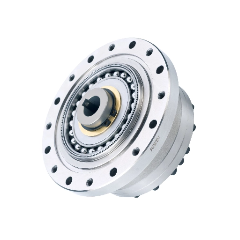Strain wave gearboxes
Zero backlash - ideal for robotic / medical / optics applications
Strain wave gear designs offer zero backlash without preload offering superior positional and repeatability performance over other pre-loaded gear solutions.
Our range of strain wave reducers offers a wide range of configurations and ratios to meet your expectations.
Composition of strain wave gearing

The composition of strain wave transmissions differs from planetary structures.
Strain wave gearboxes are mainly composed of three parts:
-
The wave generator, which is composed of a flexible bearing and an elliptical former. The wave generator is usually installed at the input end of the speed reducer.
-
The flexible gear is a thin wall gear with outer teeth that when the wave generator is pushed inside deforms to create an elliptical gear.
-
An outer gear (circular spline) with teeth cut onto the inside.
-
The wave generator is located inside the flexible gear, deforming it to create a flexible elliptical gear. This gear engages into the circular spline, allowing for teeth to engage over the major axis and clearance across the minor axis of flexspline.
Priniciple of strain wave reduction
The strain wave gear reduction uses the elastic deformation of a flexible gear and functions as below:
- The elliptical wave generator is inserted into the flexspline deforming this into a flexible elliptical gear.
- The flexible gear has 2 x the number of teeth as the ratio required*.
- The circular spline has 2 x the number of teeth as the ratio + 2 additional teeth.
- When the flexpline is inserted in the circular spline the teeth engage over the major axis with clearance across the minor axis
- A large number of teeth across the major axis are either in full or partially engaged at any one time
- As the input is rotated for each 1 rotation of the motor the flexspline regresses 2 tooth in relationship to the fixed circular spline
- For 80 rotations of the input with 160 teeth on the flexible gear and the 2 teeth regression in relationship to the fixed circular spline the ratio provided is 160/2 = 8:1
*Ratios below 50:1 have a 4 tooth difference.
Advantages of strain wave gearboxes compared to planetary :
Compact design
- High ratios can be achieved in a single-stage construction (short axial length)
- Highest power/weight ratio for any gearbox type
- The flexspline can be fixed with the circular spline as the output offer a “wheel drive concept” for ultra compact design.
Precision
-
Backlash is reduced to zero (whereas planetary gearboxes can only reach a reduced backlash of 1 arc-minute until they become overconstrained)
- Gears are not preloaded radially providing to excellent positional accuracy and repeatability and minimal hysteresis loss
Stiffness
-
High torsional stiffness for predictable move profiling and tuning
- Hysterisis is minimised due to multiple teeth engaging over the major axis of the flexspline/circular spline contac
Can be used as a differential gear
Our line covers a variety of sizes and models including
-
Integrated bearing option
- Hollow shaft option for services/optical trains to be fed through
Do not hesitate to ask for drawings.